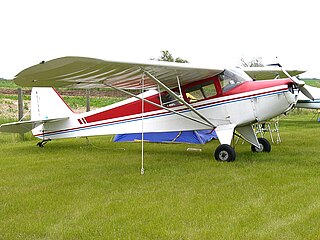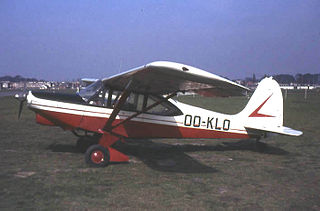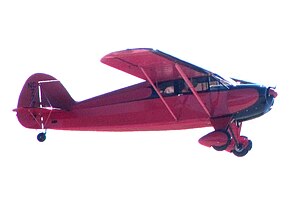
The Taylorcraft B is an American light, single-engine, high-wing general aviation monoplane, with two seats in side-by-side configuration, that was built by the Taylorcraft Aviation Corporation of Alliance, Ohio.

The RyanNavion is a single-engine, unpressurized, retractable gear, four-seat aircraft originally designed and built by North American Aviation in the 1940s. It was later built by Ryan Aeronautical Company and the Tubular Steel Corporation (TUSCO).

The Piper J-5 Cub Cruiser was a larger, more powerful version of the basic Piper J-3 Cub. It was designed just two years after the J-3 Cub, and differed by having a wider fuselage with the pilot sitting in the front seat and two passengers sitting in the rear seat. Equipped with a 75-hp Continental engine the plane's cruising speed was 75 mph. Though officially a three-seater, it would be more accurately described as a "two-and-a-half-seater", as two adults would find themselves quite cramped in the wider rear seat. The Cruiser sold for $1,798 when it was first designed.

The Cessna Model 411 is an American twin-engined, propeller-driven, non-pressurized light aircraft built by Cessna Aircraft. It was that company's largest business aircraft to enter production when it first flew in 1962.

The Boisavia B.60 Mercurey was a series of four-seat light aircraft developed in France shortly after World War II.

The Call-Air Model A is an American two- to three-seat utility aircraft designed by the Call brothers and built by the Call Aircraft Company, later developed into a successful line of agricultural aircraft.

The Stinson Voyager was an American light utility monoplane built during the 1940s by the Stinson Aircraft Company.

The Colonial Model C-1 Skimmer was an American small single-engined amphibian flying boat built by the Colonial Aircraft Corporation. It was the start of a line of very similar aircraft designed by David Thurston.

The Funk F-23 was an agricultural aircraft produced in the United States during the 1960s. It was designed by Donald Funk using the fuselage frame of military surplus Fairchild PT-23 trainers as a starting point. The resulting aircraft was a low-wing cantilever monoplane with fixed, tailwheel undercarriage and all-metal construction. The main structural changes were in the wing, which had all-new outer panels. The space occupied by the forward cockpit of the PT-23 was used to accommodate a 200 U.S. gallon hopper for chemicals. Production continued until 1970, when manufacturing rights to the design were purchased by Cosmic Aircraft. The new owner, however, produced no further examples of the type.

The Piel CP-30 Emeraude is an aircraft designed in France in the mid-1950s and widely built both by factories and homebuilders.

The FMA 20 El Boyero ("Shepherd") was a light utility aircraft produced in Argentina in the 1940s. It was a conventional high-wing strut-braced monoplane with a fixed tailskid undercarriage, seating two side by side in an enclosed cabin.

The Macchi MB.308, later Aermacchi MB-308, is a light aircraft produced in Italy in the late 1940s.

The Meyers MAC-125 is a light sport aircraft developed in the United States in 1947, produced in a small series as the MAC-145.

The Culver Model V is a two-seat cabin monoplane designed and built by the Culver Aircraft Company.
The Taylorcraft Model 20 Ranch Wagon was a four-seat cabin monoplane designed and built by Taylorcraft Aircraft as a development of the earlier experimental Model 18. The Model 20 was constructed of moulded fibreglass over a tubular framework. It had a conventional landing gear and a nose-mounted 225 hp (168 kW) Continental O-470-J engine.

The Varga 2150 Kachina is an American all-metal, low-wing, fixed-gear, two-seat light aircraft fitted with a tricycle undercarriage.

The SIPA S.90 was a French-built two-seat light touring and training aircraft of the 1940s and 1950s.

The Ambrosini Rondone is an Italian-designed two/three-seat light touring monoplane of the early 1950s.

The Scheibe SF-23 Sperling (en:Sparrow) is a 1950s German two-seat cabin monoplane.
The Viberti Musca 1 is a 1940s Italian two-seat civil touring monoplane produced by Ali Verberti SpA of Turin.






















